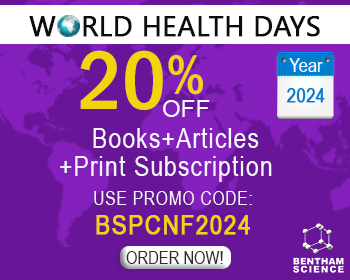Abstract
Quinones are a huge class of compounds with affluent and captivating chemistry. p-Benzoquinone (p-BNZ) or 1,4-Benzoquinone is the key structural motif of numerous biologically active synthetic and natural compounds. This draws interest in its biological exploration to assess prospective therapeutic implications. It possesses immense therapeutic potential depending on different substitutions. This moiety has a marvelous potential to regulate a varied range of different cellular pathways which can be investigated for various selective activities. p-Benzoquinones have been a requisite core for the development of novel therapeutic molecules with minimum side effects. In this review, various synthetic, pharmacological approaches and structure-activity relationship studies focusing on the chemical groups responsible for evoking the pharmacological potential of p-benzoquinone derivatives have been emphasized. Additionally, the compilation highlights the chemical, pharmaceutical and medicinal aspects of synthetic and natural benzoquinone derivatives. The natural occurrences of p-benzoquinone derivatives with different pharmacological significance have also been reported in this review.
Keywords: p-Benzoquinone, quinone, natural occurrences, anti-Alzheimer, antioxidant, anti-inflammatory.
[http://dx.doi.org/10.1016/0041-008X(92)90273-U] [PMID: 1733045]
[PMID: 7771081]
[http://dx.doi.org/10.1556/2060.103.2016.4.4] [PMID: 28229632]
[http://dx.doi.org/10.1016/j.bmc.2006.08.036] [PMID: 16971128]
[http://dx.doi.org/10.1002/anie.200700256] [PMID: 17397121]
[http://dx.doi.org/10.1016/j.nurt.2008.10.042] [PMID: 19110206]
[http://dx.doi.org/10.1021/jm5010804] [PMID: 25259726]
[http://dx.doi.org/10.1021/cr00030a003]
[http://dx.doi.org/10.1590/S0103-50532009000100026]
[http://dx.doi.org/10.1002/cbic.200700196] [PMID: 17661303]
[http://dx.doi.org/10.1016/0009-2797(91)90029-7] [PMID: 1913977]
[http://dx.doi.org/10.1248/cpb.c15-00607] [PMID: 26633024]
[http://dx.doi.org/10.2174/157489106775244073] [PMID: 18221140]
[http://dx.doi.org/10.1023/B:UROL.0000034652.88578.a8] [PMID: 15368706]
[http://dx.doi.org/10.1074/jbc.M302297200] [PMID: 12736273]
[http://dx.doi.org/10.1093/qjmed/hch089] [PMID: 15256611]
[http://dx.doi.org/10.1080/10408390902773037] [PMID: 20301015]
[http://dx.doi.org/10.1055/s-2007-990242] [PMID: 17939102]
[http://dx.doi.org/10.1080/14786410500045721] [PMID: 16286313]
[http://dx.doi.org/10.1002/cber.19650980924]
[http://dx.doi.org/10.1021/cr60260a002]
[http://dx.doi.org/10.1021/ja00756a040]
[http://dx.doi.org/10.1021/jo801057x] [PMID: 18681403]
[http://dx.doi.org/10.1080/00397918908052603]
[http://dx.doi.org/10.1021/jo00365a044]
[http://dx.doi.org/10.1021/jo9613803]
[http://dx.doi.org/10.1590/S0103-50532005000600029]
[http://dx.doi.org/10.1080/00397919808006862]
[http://dx.doi.org/10.1016/j.tetlet.2010.03.007]
[http://dx.doi.org/10.1021/jo00884a035] [PMID: 985642]
[http://dx.doi.org/10.3233/JAD-2006-9S317] [PMID: 16914853]
[http://dx.doi.org/10.1016/j.ajpath.2011.07.004] [PMID: 21854751]
[http://dx.doi.org/10.1523/JNEUROSCI.0858-11.2011] [PMID: 21715616]
[http://dx.doi.org/10.3233/JAD-2008-14210] [PMID: 18560133]
[http://dx.doi.org/10.1016/0006-3002(57)90457-2] [PMID: 13445756]
[http://dx.doi.org/10.1074/jbc.M501527200] [PMID: 15788391]
[http://dx.doi.org/10.2174/156802611798184373] [PMID: 22039879]
[http://dx.doi.org/10.1016/j.bmcl.2010.12.093] [PMID: 21236667]
[http://dx.doi.org/10.1021/jm981038d] [PMID: 9767650]
[http://dx.doi.org/10.1021/jm9810452] [PMID: 9784091]
[http://dx.doi.org/10.1023/B:JOBB.0000041772.74810.92] [PMID: 15377876]
[http://dx.doi.org/10.1177/153331750502000103] [PMID: 15751450]
[http://dx.doi.org/10.1073/pnas.0602922103] [PMID: 16731619]
[http://dx.doi.org/10.1021/jm070559a] [PMID: 17850125]
[http://dx.doi.org/10.1016/0014-5793(90)81497-C] [PMID: 2365068]
[http://dx.doi.org/10.1016/S0006-291X(03)01229-4] [PMID: 12893287]
[http://dx.doi.org/10.7164/antibiotics.23.442] [PMID: 5459626]
[http://dx.doi.org/10.1021/ol0267432] [PMID: 12323066]
[http://dx.doi.org/10.7164/antibiotics.32.255] [PMID: 468713]
[http://dx.doi.org/10.1016/S0040-4020(01)92041-1]
[http://dx.doi.org/10.1016/S0040-4039(00)97531-2]
[http://dx.doi.org/10.7164/antibiotics.53.657] [PMID: 10994806]
[http://dx.doi.org/10.7164/antibiotics.39.415] [PMID: 3700243]
[http://dx.doi.org/10.7164/antibiotics.32.849] [PMID: 500504]
[http://dx.doi.org/10.1016/S0378-1097(02)01148-5] [PMID: 12586396]
[http://dx.doi.org/10.1016/0006-291X(75)90137-0] [PMID: 1096888]
[http://dx.doi.org/10.1016/j.tetlet.2007.05.052]
[http://dx.doi.org/10.1007/s12272-009-1402-z] [PMID: 19407964]
[http://dx.doi.org/10.1128/AAC.01118-05] [PMID: 16723594]
[http://dx.doi.org/10.1111/jph.12253]
[PMID: 13853494]
[http://dx.doi.org/10.1021/np50016a019]
[http://dx.doi.org/10.1016/j.ejmech.2012.07.022] [PMID: 22939606]
[http://dx.doi.org/10.1016/j.canlet.2010.03.004] [PMID: 20363069]
[http://dx.doi.org/10.1016/j.yexcr.2010.02.045] [PMID: 20211171]
[http://dx.doi.org/10.1016/S0092-8674(00)81683-9] [PMID: 10647931]
[http://dx.doi.org/10.1021/jm00191a006] [PMID: 458799]
[http://dx.doi.org/10.1007/BF00631303] [PMID: 13188198]
[http://dx.doi.org/10.1055/s-0028-1115792] [PMID: 13330468]
[http://dx.doi.org/10.1200/JCO.1992.10.1.143] [PMID: 1727916]
[http://dx.doi.org/10.1016/0006-2952(89)90581-9] [PMID: 2557029]
[http://dx.doi.org/10.1073/pnas.83.12.4514] [PMID: 3086887]
[http://dx.doi.org/10.1021/ja00086a006]
[http://dx.doi.org/10.1016/j.bmc.2007.10.028] [PMID: 17964791]
[http://dx.doi.org/10.1007/s00044-007-9001-3]
[http://dx.doi.org/10.1126/science.142.3596.1181] [PMID: 14069241]
[http://dx.doi.org/10.1016/j.ejmech.2018.02.059] [PMID: 29486369]
[http://dx.doi.org/10.1016/j.cell.2010.01.025] [PMID: 20303878]
[http://dx.doi.org/10.1161/ATVBAHA.110.207449] [PMID: 21508345]
[http://dx.doi.org/10.1016/j.tibs.2007.06.002] [PMID: 17576065]
[http://dx.doi.org/10.1056/NEJMra071371] [PMID: 17978293]
[PMID: 1848634]
[http://dx.doi.org/10.1021/np000637w] [PMID: 11374954]
[http://dx.doi.org/10.1002/art.1780360208] [PMID: 8431207]
[PMID: 2182625]
[http://dx.doi.org/10.1016/j.ejmech.2010.11.028] [PMID: 21163556]
[http://dx.doi.org/10.1016/j.ejmech.2013.06.039] [PMID: 23871907]
[http://dx.doi.org/10.1016/j.ejmech.2015.02.042] [PMID: 25765759]
[http://dx.doi.org/10.1016/j.bmcl.2012.11.006] [PMID: 23206864]
[PMID: 9511847]
[http://dx.doi.org/10.1016/S0899-9007(02)00916-4] [PMID: 12361782]
[http://dx.doi.org/10.1042/BJ20081386] [PMID: 19061483]
[http://dx.doi.org/10.1016/j.ejmech.2014.09.042] [PMID: 25232967]
[http://dx.doi.org/10.1016/j.bmc.2010.06.104] [PMID: 20691600]
[http://dx.doi.org/10.1016/j.bmc.2013.01.075] [PMID: 23473946]
[http://dx.doi.org/10.1021/np3007099] [PMID: 23190044]
[http://dx.doi.org/10.1016/j.bioelechem.2016.05.008] [PMID: 27268099]
[http://dx.doi.org/10.1021/ja110190t] [PMID: 21548646]
[http://dx.doi.org/10.1038/srep01865] [PMID: 23689559]
[http://dx.doi.org/10.1007/s10008-016-3230-7]
[http://dx.doi.org/10.1093/eurjhf/hfp042] [PMID: 19346534]
[http://dx.doi.org/10.1161/01.RES.0000100665.67510.F5] [PMID: 14551246]
[http://dx.doi.org/10.1016/j.yjmcc.2005.06.016] [PMID: 16125722]
[http://dx.doi.org/10.1016/S0022-2828(03)00145-7] [PMID: 12818576]
[http://dx.doi.org/10.1016/j.bbamem.2003.11.012] [PMID: 14757233]
[http://dx.doi.org/10.1038/sj.ejcn.1600880] [PMID: 10556981]
[http://dx.doi.org/10.1073/pnas.87.12.4879] [PMID: 2352956]
[http://dx.doi.org/10.1016/0925-4439(95)00028-3] [PMID: 7599208]
[http://dx.doi.org/10.1586/erc.10.63] [PMID: 20528640]
[http://dx.doi.org/10.1007/s00049-003-0259-8]
[http://dx.doi.org/10.1007/s10886-016-0680-4] [PMID: 26971956]
[http://dx.doi.org/10.1023/A:1026489826714]
[http://dx.doi.org/10.1007/s00114-003-0427-2] [PMID: 12883771]
[http://dx.doi.org/10.1016/0891-5849(89)90126-3] [PMID: 2691341]
[http://dx.doi.org/10.1021/tx9902082] [PMID: 10725110]
[http://dx.doi.org/10.1016/j.redox.2019.101400] [PMID: 31926625]
[http://dx.doi.org/10.1093/toxsci/kft256] [PMID: 24213144]
[http://dx.doi.org/10.1021/jo201320g] [PMID: 21866924]
[http://dx.doi.org/10.1002/anie.201003565] [PMID: 20803595]
[http://dx.doi.org/10.1590/S0103-50532009000100026]
[http://dx.doi.org/10.1002/anie.197405591] [PMID: 4214098]
[http://dx.doi.org/10.1021/jm00109a016] [PMID: 2033589]
[http://dx.doi.org/10.1021/jm00243a012] [PMID: 1159713]
[http://dx.doi.org/10.1073/pnas.92.18.8171] [PMID: 7667263]
[http://dx.doi.org/10.1021/jf047883o] [PMID: 15853381]
[http://dx.doi.org/10.1021/np070436t] [PMID: 18052030]
[http://dx.doi.org/10.1007/BF01946484]
[http://dx.doi.org/10.1021/jf800331r] [PMID: 18461966]
[http://dx.doi.org/10.1016/S0014-5793(03)01289-4] [PMID: 14644444]
[http://dx.doi.org/10.1016/S0031-9422(96)00652-8] [PMID: 9115701]
[http://dx.doi.org/10.1016/S0031-9422(98)00626-8]
[http://dx.doi.org/10.1016/S0031-9422(02)00474-0] [PMID: 12453518]
[http://dx.doi.org/10.1021/np0701069] [PMID: 17892262]
[http://dx.doi.org/10.1016/S0031-9422(96)00606-1]
[http://dx.doi.org/10.1021/jo702101w] [PMID: 17999537]
[http://dx.doi.org/10.1021/np060284m] [PMID: 17125236]
[http://dx.doi.org/10.1016/S0031-9422(03)00428-X] [PMID: 14559281]
[http://dx.doi.org/10.1016/j.phytochem.2004.02.024] [PMID: 15110692]
[http://dx.doi.org/10.1016/j.phytochem.2005.05.024] [PMID: 16019043]
[http://dx.doi.org/10.1039/b006897g] [PMID: 11245399]
[http://dx.doi.org/10.3390/md504151] [PMID: 18463729]
[http://dx.doi.org/10.1016/S0040-4020(01)85557-5]
[http://dx.doi.org/10.1016/0040-4020(95)00661-Q]
[http://dx.doi.org/10.1016/j.bmc.2008.07.028] [PMID: 18676149]
[http://dx.doi.org/10.1016/j.bmc.2008.10.080] [PMID: 19017563]
[http://dx.doi.org/10.1021/ja011413i] [PMID: 11716712]
[http://dx.doi.org/10.1016/0040-4020(79)87004-0]
[http://dx.doi.org/10.1248/cpb.52.935] [PMID: 15304984]
[http://dx.doi.org/10.1016/j.tet.2007.06.031]
[http://dx.doi.org/10.1016/S0040-4039(00)93575-5]
[http://dx.doi.org/10.1021/np070600c] [PMID: 18247573]
[http://dx.doi.org/10.1021/np9804942] [PMID: 10346952]
[http://dx.doi.org/10.1139/y85-034] [PMID: 2985221]
[http://dx.doi.org/10.1126/science.7901908] [PMID: 7901908]
[http://dx.doi.org/0.1111/j.1471-4159.1992.tb10990.x] [PMID: 1402908]
[http://dx.doi.org/10.1021/np960253z] [PMID: 8946751]
[http://dx.doi.org/10.1021/np970071k] [PMID: 9214737]
[http://dx.doi.org/10.1016/j.tet.2007.03.093]
[http://dx.doi.org/10.1016/S0040-4039(01)98959-2]
[http://dx.doi.org/10.1248/cpb.43.1391] [PMID: 7553985]
[http://dx.doi.org/10.1248/cpb.46.1770]
[http://dx.doi.org/10.1016/S0031-9422(01)00317-X] [PMID: 11738414]
[http://dx.doi.org/10.1021/jf052407z] [PMID: 16536574]
[http://dx.doi.org/10.1016/S0031-9422(97)00403-2]
[http://dx.doi.org/10.1016/S0031-9422(98)80060-5]
[http://dx.doi.org/10.1016/j.bmc.2005.02.028] [PMID: 15781385]
[http://dx.doi.org/10.1126/science.1107163] [PMID: 15718472]
[http://dx.doi.org/10.1021/tx060166z] [PMID: 17226928]
[http://dx.doi.org/10.1073/pnas.1812334116] [PMID: 31182590]



























